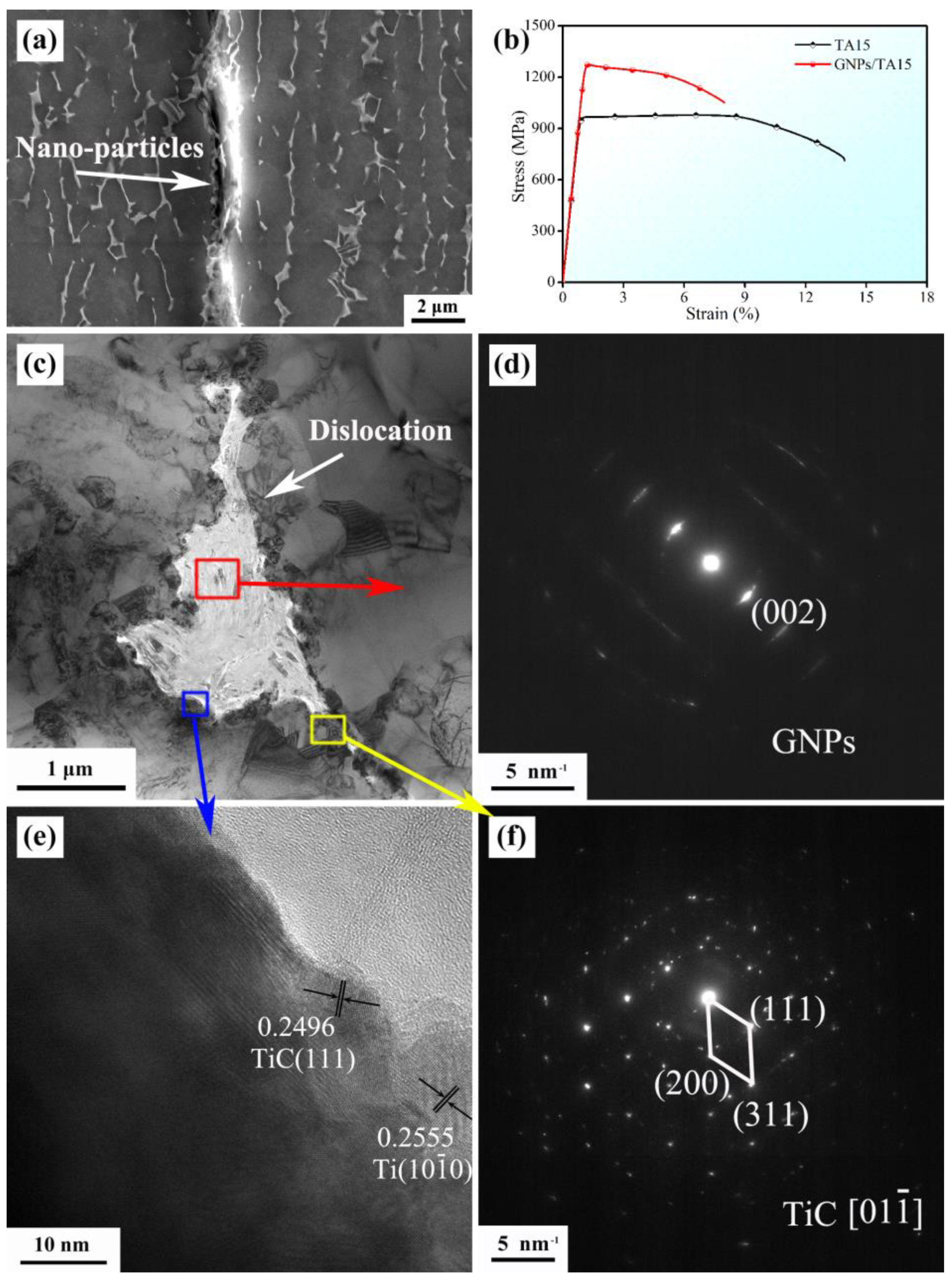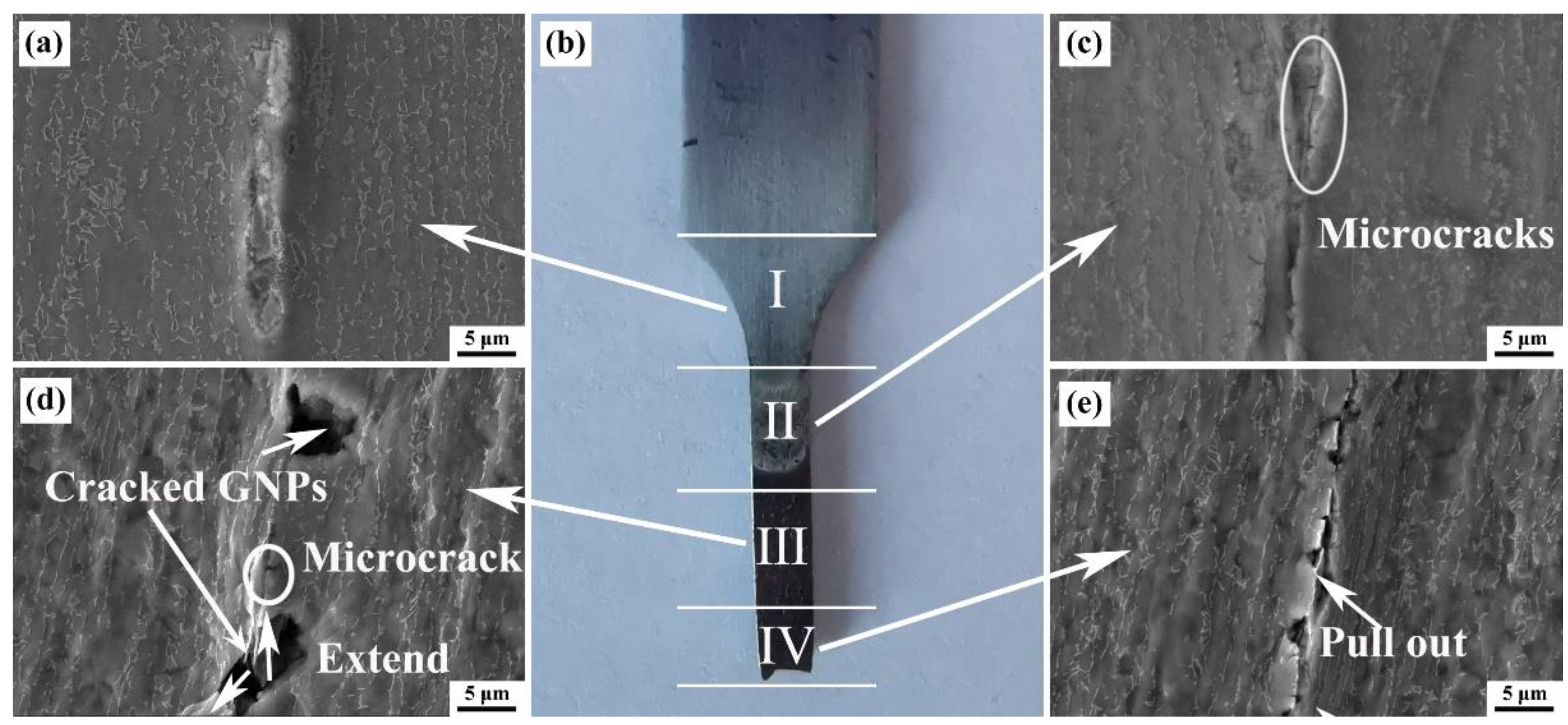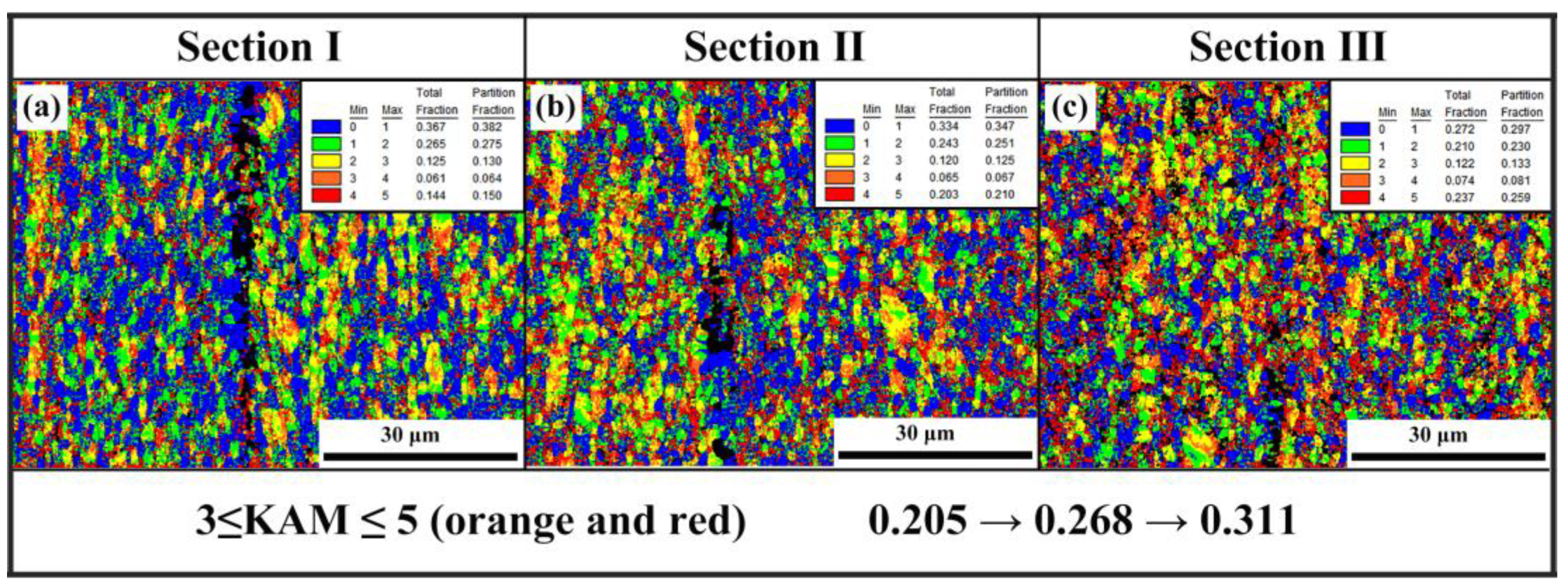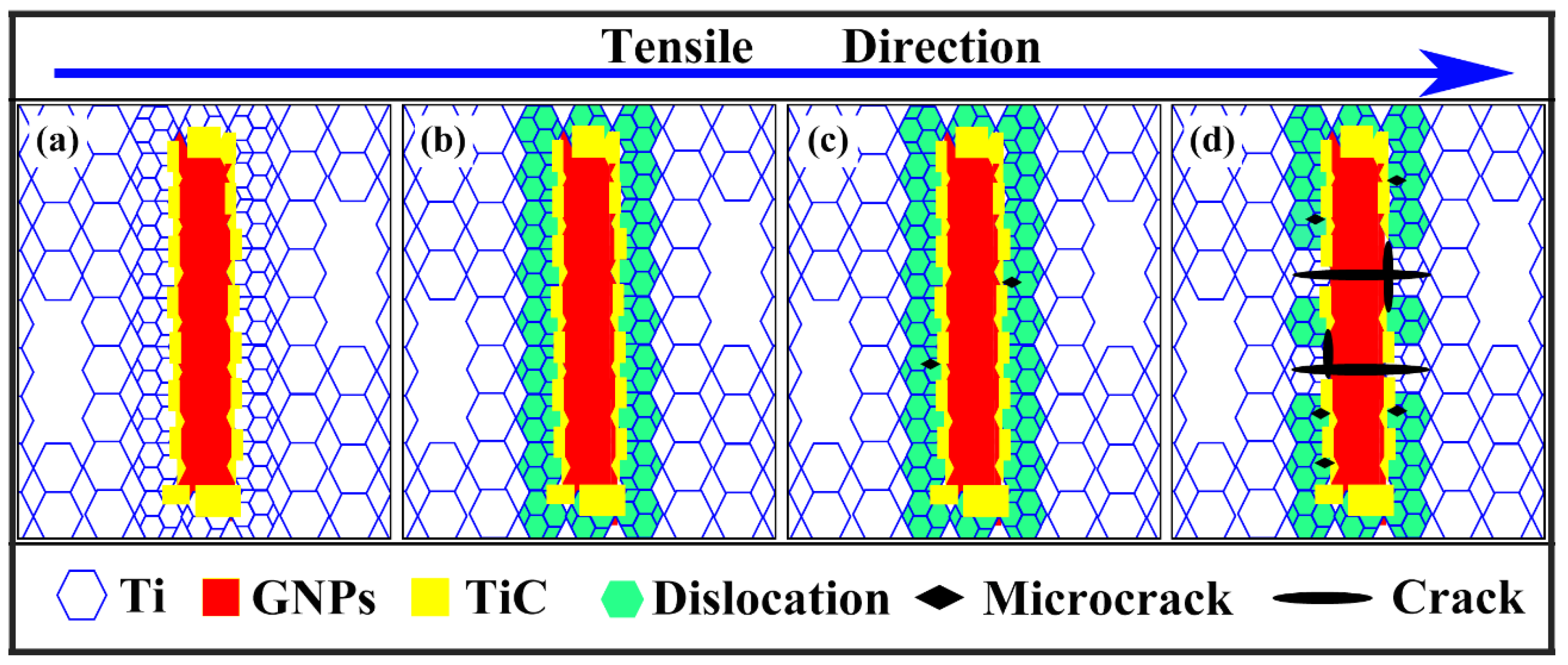The Room Temperature Fracture Behaviors of GNPs/TA15 Composites by Pre-Sintering and Hot Extrusion
Abstract
1. Introduction
2. Materials and Methods
3. Results and Discussion
4. Conclusions
Author Contributions
Funding
Informed Consent Statement
Data Availability Statement
Conflicts of Interest
References
- Balandin, A.A.; Ghosh, S.; Bao, W.; Calizo, I.; Teweldebrhan, D.; Miao, F.; Lau, C.N. Superior Thermal Conductivity of Single-Layer Graphene. Nano Lett. 2008, 8, 902–907. [Google Scholar] [CrossRef]
- Berry, V. Impermeability of graphene and its applications. Carbon 2013, 62, 1–10. [Google Scholar] [CrossRef]
- Geim, A.K. Graphene: Status and prospects. Science 2009, 324, 1530–1534. [Google Scholar] [CrossRef]
- Zhang, X.; Xu, Y.; Wang, M.; Liu, E.; Zhao, N.; Shi, C.; Lin, D.; Zhu, F. A powder-metallurgy-based strategy toward three-dimensional graphene-like network for reinforcing copper matrix composites. Nat. Commun. 2020, 11, 2775. [Google Scholar] [CrossRef]
- Wu, G.; Yu, Z.; Jiang, L.; Zhou, C.; Deng, G.; Deng, X.; Xiao, Y. A novel method for preparing graphene nanosheets/Al composites by accumulative extrusion-bonding process. Carbon 2019, 152, 932–945. [Google Scholar] [CrossRef]
- Bartolucci, S.F.; Paras, J.; Rafiee, M.A.; Rafiee, J.; Lee, S.; Kapoor, D.; Koratkar, N. Graphene–aluminum nanocomposites. Mater. Sci. Eng. A 2011, 528, 7933–7937. [Google Scholar] [CrossRef]
- Guo, B.; Chen, B.; Zhang, X.; Cen, X.; Wang, X.; Song, M.; Ni, S.; Yi, J.; Shen, T.; Du, Y. Exploring the size effects of Al4C3 on the mechanical properties and thermal behaviors of Al-based composites reinforced by SiC and carbon nanotubes. Carbon 2018, 135, 224–235. [Google Scholar] [CrossRef]
- Wu, L.; Wu, R.; Hou, L.; Zhang, J.; Zhang, M. Microstructure, mechanical properties and wear performance of AZ31 matrix composites reinforced by graphene nanoplatelets(GNPs). J. Alloys Compd. 2018, 750, 530–536. [Google Scholar] [CrossRef]
- Arab, M.; Marashi, S. Effect of graphene nanoplatelets (GNPs) content on improvement of mechanical and tribological properties of AZ31 Mg matrix nanocomposite. Tribol. Int. 2018, 132, 1–10. [Google Scholar] [CrossRef]
- Guo, S.; Zhang, X.; Shi, C.; Liu, E.; He, C.; He, F.; Zhao, N. Enhanced mechanical properties and electrical conductivity of graphene nanoplatelets/Cu composites by in situ formation of Mo2C nanoparticles. Mater. Sci. Eng. A 2019, 766, 138365. [Google Scholar] [CrossRef]
- Chu, K.; Li, Y.; Wang, X.; Huang, D.; Zhang, H. Interface structure and strengthening behavior of graphene/CuCr composites. Carbon 2018, 133, 127–139. [Google Scholar] [CrossRef]
- Chu, K.; Li, Y.; Li, Y.; Jia, C.; Zhang, H. Creating defects on graphene basal-plane toward interface optimization of graphene/CuCr composites. Carbon 2019, 143, 85–96. [Google Scholar] [CrossRef]
- Cao, H.C. The microstructures and mechanical properties of graphene-reinforced titanium matrix composites. J. Alloys Compd. 2020, 812, 152057. [Google Scholar] [CrossRef]
- Liu, L.; Li, Y.; Zhang, H.; Cheng, X.; Mu, X.; Yi, J. Graphene nanoplatelets (GNPs)-templated synthesis of oriented TiB and the inspiration for tailoring three-dimensional (3D) interface structure in GNPs/Ti matrix composites. Mater. Charact. 2021, 181, 111447. [Google Scholar] [CrossRef]
- Hou, J.; Chi, F.; Chi, L.; Cui, G.; Chen, W.; Zhang, W. Effects of the interface and mechanical properties of GNPs/TA15 composites through adding B powders. J. Alloys Compd. 2021, 902, 162538. [Google Scholar] [CrossRef]
- Mu, X.; Cai, H.; Zhang, H.; Fan, Q.; Zhang, Z.; Wu, Y.; Ge, Y.; Wang, D. Interface evolution and superior tensile properties of multi-layer graphene reinforced pure Ti matrix composite. Mater. Des. 2018, 140, 431–441. [Google Scholar] [CrossRef]
- Mu, X.; Chen, P.; Zhang, H.; Cheng, X.; Liu, L.; Ge, Y. Interface-dependent failure behaviors in graphene nanoflakes reinforced Ti matrix composites. Mater. Lett. 2021, 289, 129422. [Google Scholar] [CrossRef]
- Feng, Y.; Zhang, W.; Cui, G.; Chen, W.; Yu, Y. Room temperature tensile fracture characteristics of the oriented TiB whisker reinforced TA15 matrix composites fabricated by pre-sintering and canned extrusion. Mater. Sci. Eng. A 2017, 707, 40–43. [Google Scholar] [CrossRef]
- Hou, J.; Chi, F.; Cui, G.; Chen, W.; Zhang, W. Strengthening effects of in-situ synthetic nano-TiC particles on Ti64 based nanocomposites through adding graphene nanoplatelets. Vacuum 2020, 177, 109431. [Google Scholar] [CrossRef]
- Xiong, D.-B.; Cao, M.; Guo, Q.; Tan, Z.; Fan, G.; Li, Z.; Zhang, D. Graphene-and-Copper Artificial Nacre Fabricated by a Preform Impregnation Process: Bioinspired Strategy for Strengthening-Toughening of Metal Matrix Composite. ACS Nano 2015, 9, 6934–6943. [Google Scholar] [CrossRef]
- Shao, P.; Chen, G.; Ju, B.; Yang, W.; Zhang, Q.; Wang, Z.; Tan, X.; Pei, Y.; Zhong, S.; Hussain, M.; et al. Effect of hot extrusion temperature on graphene nanoplatelets reinforced Al6061 composite fabricated by pressure infiltration method. Carbon 2020, 162, 455–464. [Google Scholar] [CrossRef]




| Elements | Ti | Al | Mo | V | Zr |
|---|---|---|---|---|---|
| Content(wt.%) | 89.997 | 6.24 | 1.00 | 1.61 | 1.96 |
Disclaimer/Publisher’s Note: The statements, opinions and data contained in all publications are solely those of the individual author(s) and contributor(s) and not of MDPI and/or the editor(s). MDPI and/or the editor(s) disclaim responsibility for any injury to people or property resulting from any ideas, methods, instructions or products referred to in the content. |
© 2022 by the authors. Licensee MDPI, Basel, Switzerland. This article is an open access article distributed under the terms and conditions of the Creative Commons Attribution (CC BY) license (https://creativecommons.org/licenses/by/4.0/).
Share and Cite
Hou, J.; Zhang, W.; Cui, G.; Chen, W.; Wang, X.; Wu, S.; Ma, Q. The Room Temperature Fracture Behaviors of GNPs/TA15 Composites by Pre-Sintering and Hot Extrusion. Materials 2023, 16, 318. https://doi.org/10.3390/ma16010318
Hou J, Zhang W, Cui G, Chen W, Wang X, Wu S, Ma Q. The Room Temperature Fracture Behaviors of GNPs/TA15 Composites by Pre-Sintering and Hot Extrusion. Materials. 2023; 16(1):318. https://doi.org/10.3390/ma16010318
Chicago/Turabian StyleHou, Jiabin, Wencong Zhang, Guorong Cui, Wenzhen Chen, Xing Wang, Shuo Wu, and Qiang Ma. 2023. "The Room Temperature Fracture Behaviors of GNPs/TA15 Composites by Pre-Sintering and Hot Extrusion" Materials 16, no. 1: 318. https://doi.org/10.3390/ma16010318
APA StyleHou, J., Zhang, W., Cui, G., Chen, W., Wang, X., Wu, S., & Ma, Q. (2023). The Room Temperature Fracture Behaviors of GNPs/TA15 Composites by Pre-Sintering and Hot Extrusion. Materials, 16(1), 318. https://doi.org/10.3390/ma16010318







